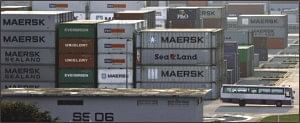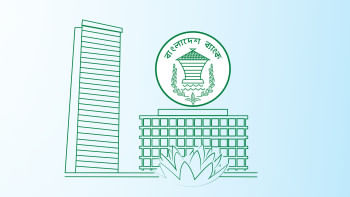Asian shipping loses steam

A view of the container port of Tanjung Pelepas in southern Johor state, Malaysia. The ports and shipping lanes of Asia are beginning to seize up as the financial turmoil strangles demand. Photo: AFP
The ports and shipping lanes of Asia, the arteries of world trade through which goods and commodities surged in the boom times, are starting to seize up as the financial crisis strangles demand.
The Baltic Dry Index, a signpost of economic trends which tracks the cost of moving goods across the oceans, has set off alarm bells by plummeting 85 percent from its peak in May to a six-year low.
Share prices of some major shipping companies, which haul bulk freight such as iron ore, coal and grains destined to be turned into manufactured goods, have fallen 50-70 percent in the past few months.
"The global economic slowdown will push some shipping lines into bankruptcy," Marc Faber, a famed investor and editor of the "Gloom Boom & Doom" report, told AFP.
Standard & Poor's also said this week that the Asian shipping market has suffered double-digit declines on the US-Asia route in June and July, as well as being hit with higher operating costs.
The industry had been expecting an upturn after the Beijing Olympic Games ended and factories chugged back to life, after an enforced holiday to help improve air quality. But instead disaster struck on global markets.
There are reports of idle vessels being put to anchor, and question marks over the many orders for new ships that were placed in brighter times, years ahead of expected completion dates.
"Pain levels could be high for companies that agreed to pay 2007 top-dollar prices for dry bulk ships, or who agreed to pay high long-term charters," said an article in the Far Eastern Economic Review this month.
Container shipping was hit first earlier this year as demand for Asian-made goods in the US and Europe dropped off, a casualty of the sub-prime mortgage crisis and poor consumer confidence.
In a chain reaction, the countless Asian factories churning out electronics and consumer items for the US and European markets began lowering output, and the need for raw materials declined.
Container shippers, bulk operators and port authorities across the region are reporting slowdowns.
Malaysia's Port Klang said it had been hit by a decline in cargo handling since the start of October, blaming a retail downturn and lower vehicle sales in the United States and Europe.
Shanghai International Port said that growth in cargo traffic dropped sharply to 9.9 percent in the first half of 2008 on the "increasingly grave global economy and trade situation".
"Faced with the severe economic situation at home and abroad, the port industry has met with the most complicated operation environment in recent years," it said.
Hong Kong, which is sensitive to any drop in demand for toys, gadgets and clothes made in the factory-belt of China's southern Guangdong province, said that after an increase of 6.7 percent in container traffic in August, growth dropped suddenly in September to just 1.2 percent.
"Given the global gloomy economic outlook, Hong Kong is expected to face a much tougher export trade environment," said Hong Kong Container Terminal Operators Association chairman Alan Lee.
In Taiwan's seven harbours, volumes fell 2.23 percent in the nine months to September, and in southern Kaohsiung city, business was down 1.76 percent.
"We are seeing a rapid decline in the volume of exports," an official with the Japanese Shipowners' Association said of the decline in demand.
The Baltic Dry Index which hit 11,793 in May is now under around 1,300, approaching rates not seen since the Asian financial crisis in 1997-1998, and tipped to slip below 1,000 as commodity prices fall.
A so-called capesize vessel, most commonly used to carry coal and iron ore, now costs under 11,000 dollars a day to hire, about half the charge in May.
The index's decline has alarmed observers as an indication of the damage the credit crisis has already wreaked on the world economy, even if action to revive financial markets is successful.
Container shipping lines have said they expect cargo demand on the US-Asia route to fall by as much as eight percent in 2008.
"It's a safe statement that no carrier is operating profitably in the eastbound transpacific market today," said Ron Widdows, chairman of the Transpacific Stabilisation Agreement -- a forum of major shipping lines.
However, the group said vessels are still running at 90 percent capacity as firms cut costs by consolidating routes and returning chartered vessels, and take advantage of the downturn to lay up ships for repairs.
Widdows said the industry was confident that government efforts to unclog global finance would be effective, restoring confidence and paving the way for a shipping recovery in late 2009.

 For all latest news, follow The Daily Star's Google News channel.
For all latest news, follow The Daily Star's Google News channel. 



Comments